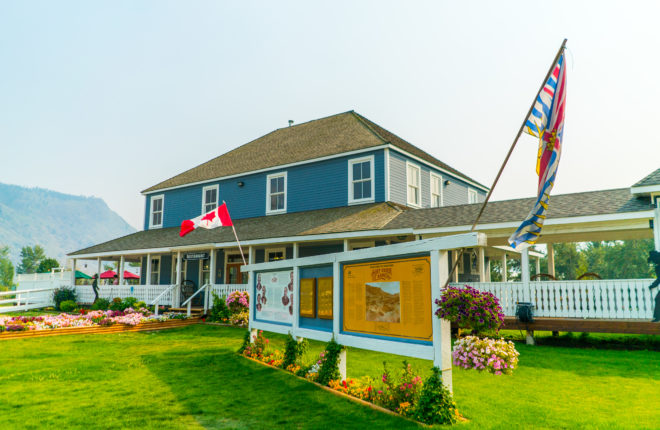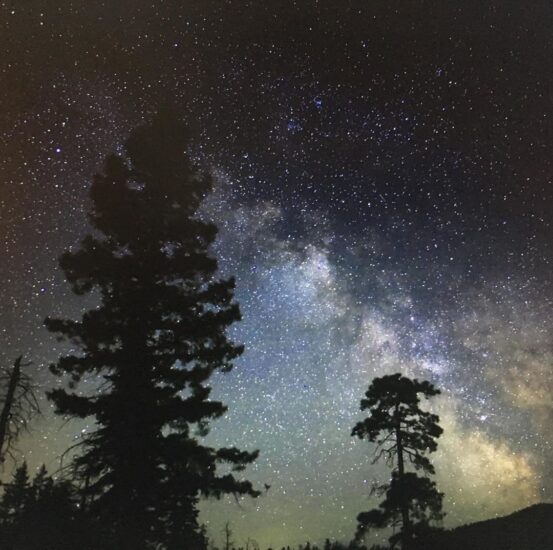Travel Info
- Distance
- ~ 93 km / 58 miles Trans-Canada Hwy/BC-1 W and via Tunkwa Lake Rd
- Suggested Trip Time
- 1 Day
STOPS ON THIS LEG OF THE GOLD RUSH TRAIL
McAbee Fossil Beds are some 50 million years old
Travel from the deserty sagebrush hills of the historic gold rush roadhouse at Historic Hat Creek to Logan Lake, a picturesque town located in the heart of the Highland Valley surrounded by forested rolling hills, punctuated with serene lakes and rivers. On the way, you can walk through the sagebrush and explore McAbee Fossil Beds Heritage Site. The site is part of an old lake bed which was deposited about 50 million years ago. The fossil site is the most diverse in British Columbia, with plants and insects of the Eocene Epoch, the site is known worldwide for its incredible abundance, diversity and quality of fossils. After a stop at McAbee, on the shores of beautiful Kamloops Lake, just west of Kamloops is the community of Savona, named after Francois Savona who in 1859 established a ferry service across the Thompson River where it flows out of Kamloops Lake. Between 1865 and 1885, Savona was the eastern terminus of the BX Stage Coach Line.
Ideally located at the junction of Highways 97 and 99, explore the original buildings used by gold rush travellers of the 1860s at one of the few original Cariboo waggon roadhouses still open to the public. Hat Creek House was established in 1861 by former Hudson’s Bay Company trader Donald McLean. What began as a small log stopping house later became a two-storied structure, with a west wing being added in 1901. Long before fur traders, Gold Rush miners, ranchers and settlers arrived in this valley, people of the Shuswap Nation followed a nomadic lifestyle here for thousands of years. Local Stuctwesemc (“Stluck-TOW-uhsen”) people from the Bonaparte Reserve have reconstructed traditional shelters, hunting and fishing gear, cook pits, and many other items you would find in a Shuswap Village and Indigenous Interpretation Center. It is the last remaining roadhouse of its type and one of the largest ever known along the Cariboo Wagon Road. Located on 345 acres of farm and rangeland, Historic Hat Creek has 20 historic buildings dating back to 1861, and Secwepemc (Bonaparte Indian Band) prehistoric archeological sites. The buildings stand as they did in 1901; some were built as early as 1860. Between 1885 and 1905 they witnesses the busiest era of transportation along the Road, serving the needs of freight wagons and passengers of the B.C. Express line (The “BX”).
- Stroll along the same dirt road that the waggon trains and miners travelled and stop in at the historic roadhouse, where interpreters dressed in period clothing will take you on a guided tour of a bygone era.
- Enjoy a stagecoach ride along beautiful Hat Creek to the Secwepemc (Shuswap) Village, where interpretive guides share a
glimpse into their history and living cultural traditions. - Try your luck in gold panning or archery, browse the giftshop and eat a delicious lunch at the onsite café.
- Spend the night in one of their covered wagons, camp in a miner tent or stay in one of the self-contained cabins located right in the historic site.
- Take a guided tour of the old rooms to reveal an intriguing history of the personalities who operated the ranch and traveled through it on the Cariboo Wagon Road.

Set in a dramatic desert landscape and ideally located at the junction of Highways 1 and 97. Cache Creek has been a popular stopover point for travellers since the Gold Rush in the 1860s where the town acted as an important supply point. In the heart of Gold Country, nestled along the Bonaparte River, you will find accommodations, camping, vehicle services, restaurants, gift shops and supplies. Cache Creek is an ideal base for some of the best rock hounding in British Columbia, canoeing, horseback riding, fishing and hiking through dry grasslands and dramatic desert landscapes.
- Dip your toes in the Thompson River at Juniper Beach Provincial Park set in a scenic desert landscape containing sagebrush, prickly pear cactus and juniper.
- Learn about local Secwépemc (shi-huep-muh-k) culture and history and experience how prospectors and pioneers lived back in the day with a visit to nearby Historic Hat Creek.
- Try geocaching with the Gold Country GeoTourism Program that will guide you to gold rush themed caches and reward your perseverance.
- After exploring the area, indulge in a freshly baked pastry or sandwich from the local bakery or stock up on locally grown produce at one of the farm markets – Desert Hills Farm Market and Horsting’s Farmers Market are two of the largest.
- Check out nearby McAbee Fossil Beds Heritage Site that has Bonaparte Indian Band members there to greet visitors, show them around the site on the newly constructed trails, explain its history and answer questions.

The McAbee Fossil Beds Heritage Site (now a cliff face) are part of a former lake bed that was deposited more than 50-million years ago. The area is located east of Cache Creek, and west of Kamloops, just north of and visible from Highway 1/97. Over time, insects, leaves, feathers, pollen and more sank to the lake bed, where they were covered by layers of fine silt and preserved as fossils. The site is recognized as containing the province’s most diverse array of plants and insects from the Eocene Epoch and is known worldwide for the incredible abundance, diversity and quality of fossils. Although the full extent of the archaeology at the site is not known, there is evidence of First Nations habitation and use and still today this place is valued by the Bonaparte First Nation because it represents the connection of the people to the landscape and is important in oral history and sacred uses. You can find walking trails and picnic tables at the site, as well as a pit toilet and potable water.
.

Savona is a small community located at the west end of Kamloops Lake on Highway 1 about 40 min from Kamloops with semi-arid grasslands and hills surrounding the area which support cattle ranching and agriculture. Established in the 1800s, the town was originally called Savona Ferry and served as the last stagecoach stop on the Cariboo Waggon Road from Cache Creek. Travellers would disembark the BX stagecoach to board the steamship for their journey up the lake to Kamloops, or continue on to the Shuswap Lakes. When the Canadian Pacific Railway line was built on the south side of Kamloops Lake in 1885, the community was moved across the ice-covered lake, building by building, to the new south-shore site of Savona.
- If you are looking to catch some fish, you can try your luck at any of the surrounding lakes and rivers and camp, for example, at Steelhead Provincial Park where you will find 44 campsites, firepits, picnic tables, showers, and flush toilets; some of them even have power and water available.
- Deadman Valley is another place you don’t want to miss. It is a traditional gathering place of the people of the Secwépemc (shi-huep-muh-k) Nation. With European settlement and the diminishing of First Nations land, a reserve was formed around a traditional winter settlement in the Deadman Valley. Here you can see the Deadman Valley Hoodoos, the Deadman Valley Canyon and the Deadman Falls and spend much of your day exploring.
- Visit the Tunkwa Provincial Park located 24 km/ 14.9 mi from Savona on the Tunkwa Lake Road, midway between Savona and Logan Lake. The 5,100-hectare park holds two man-made trout fishing lakes, Tunkwa Lake and Leighton Lake with campgrounds located on both lakes. This is a year-round recreation area gives you many opportunities for camping, hunting, horseback riding, wildlife viewing, fishing, cross-country skiing, and snowmobiling.

Logan Lake is a picturesque town located in the Highland Valley, surrounded by forested rolling hills punctuated by lakes and rivers. “Tslakan”, a Savona Indigenous fur trader, had a daughter whose name was Anglicized as Anne Logan, and it is thought that Logan Lake derived its name from her. The first mining prospectors arrived in the Highland Valley in the 1870s, and ranchers followed in the early twentieth century, settling in nearby Mamette Lake and Meadow Creek. It wasn’t until 1970 that the town of Logan Lake was founded, to house the workers of the newly opened copper mine. The Lornex mine eventually became Highland Valley Copper, which remains the town’s biggest employer. Logan Lake pairs a vibrant shopping centre and strong sense of community with easy access to the wilderness and an abundance of activities for all tastes.
- Stop by Left Field Cider’s tasting room while in the Logan Lake area. Left Field focuses on a small batch approach to traditional cider-making which brings out the natural characteristics of the apples. Left Field has a small orchard with cider apples and an adorable pack of dogs to play with.
- The Polar Carnival in Logan Lake is crammed with fun winter activities, including an outdoor speed skating oval, an ice fishing derby and lots of activities for families.
- Another free and family-friendly event you might want to enjoy is the Logan Lake Day celebrations on the Sunday of August long weekend.
- If you enjoy the outdoors, you can find endless trail systems, fish the surrounding lakes, tee off at the challenging Golf Course or stay a while in the fully serviced campground to enjoy the solitude of Logan Lake.











